Army Lists
Regimental Standards and Cap Badges
1 - 10 | 11
- 20 | 21 - 30 | 31
- 40 | 41 - 50
| 1st Battalion
Middlesex Regiment |
 |
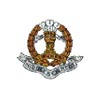 |
|
| Regimental Colour |
Cap Badge |
|
The facings of the regiment are lemon yellow, and the Regimental
Colour is of that shade. In each corner is the late Duke of
Cambridge's cypher and coronet; the regiment is known as the
"Duke of Cambridge's Own". Possibly the most famous
Battle Honour won by the Middlesex is that of Albuhera, where
they were almost wiped out. Conlonel Inglis, commanding, cheered
them on with the words, "Die hard, my men, die hard",
hence their nickname of the "Die-hards". The Regiment
was originally four battalions strong. |
| 1st Battalion
York and Lancaster Regiment |
 |
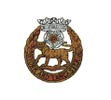 |
|
| Regimental Colour |
Cap Badge |
|
The regiment has white facings, hence the white colour with
its red cross. It bears the Royal Tiger, superscribed "India",
and the Union rose. It is interesting to nore that the latter,
seen in the bottom of the right hand corner of the colour is
not, like the roses in the central wreath, of white petals upon
red but is divided into halves of red and white. During the
Great War the Regiment expanded to 22 battalions strong. |
| 1st Battalion
Durham Light Infantry |
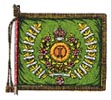 |
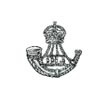 |
|
| Regimental Colour |
Cap Badge |
|
The facings of the Durham Light Infantry are dark green and
this is the ground of the Regimental Colour. The Battle Honours
of the Great War - in accordance with the usual custom - are
borne on the King's Colour, but on the scroll in the base of
the Regimental Colour, just above the united red and white rose,
appears the latest honour, "Afghanistan 1919". The
Cap Badge is the well-known Light Infantry Bugle. Originally
the 68th and 106th Foot, the Durhams had 37 battalions during
the Great War. |
| 1st Battalion
Highland Light Infantry |
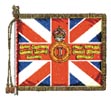 |
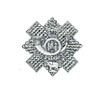 |
|
| King's Colour |
Cap Badge |
|
The H.L.I. has 32 Honours on its Regimental Colour, Ranging
from "Siege of Gibraltar" through almost everycampaign
to "South Africa 1899-1902". The Great War Honours
start with "Mons" and finish with "Archangel
1919". The two battalions of the H.L.I. were originally
the 73rd and 74th Highlanders. In 1808 the 1st Battalion became
the 71st Highland Light Infantry. The 74th were present at at
Assaye where every officer was killed or wounded; in memory
of this the 2nd Battalion carried a third ("Assaye")
colour. |
| 1st Battalion
Seaforth Highlanders |
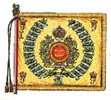 |
 |
|
| Regimental Colour |
Badge |
|
The two battalions were originally numbered the 72nd and 78th
Highlanders, the present title dating from 1881. Both were originally
raised by Earls of Seaforth and wear the Mackenzie tartan, while
the Cap Badge is the Crest of that Clan. The 2nd Battalion (like
the 2nd Battalion of the H.L.I.) has a third or "Assaye"
Colour in addition to the other two, in honour of the magnificent
part played by the 78th at Assaye. The facings of the Regiment
are buff, in accordance with the name of "Ross-shire Buffs".
|
| 2nd Battalion
Gordon Highlanders |
 |
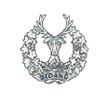 |
|
| King's Colour |
Cap Badge |
|
In the Great War the "Gay Gordons" mustered 21 battalions,
the Honours carried on the King's Colours. They won a total
of 57. When the Gordons were raised, late in the 18th century,
the Duchess of Gordon, a noted beauty of the day, promised every
recruit a kiss. The Cap Badge is the Gordon Crest. The Regiment
marches past to the air of "Highland Laddie". |
| 1st Battalion
City of London Regiment T.A. |
 |
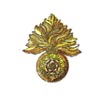 |
|
| King's Colour |
Cap Badge |
|
The London Regiment, a Territorial Army Regiment, is over 20
battalions strong. These battalions are divided into two groups,
the City of London Battalions and the Country of London Battalions.
The City Battalions are numbered from 1-8, of which the first
four are the CIty of London Regiments (Royal Fusiliers) and
these battalions are affiliated to the Regular "Royal Fusiliers"
(City of London Regiment, see 2nd Battalion
The Royal Fusiliers). In the Great War the 1st Battalion
of the City of London Regiment itself expanded to four battalions.
|
| 10th Battalion
London Regiment T.A. |
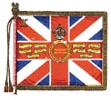 |
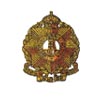 |
|
| King's Colour |
Cap Badge |
|
This Territorial Regiment - for every battalion of the London
Regiment is a regiment in itself - dates from the disbandment
of the old roth Battalion (Paddington Rifles), and the raising
of a regiment in Hackney. The Badge is the Tower of Hackney
with the motto of the borough, "Justitia Turris Nostra".
There are 10 Honours borne on the King's Colours, and the regiment
also gained 27 Battle Honours in the Great War. |
| The London Scottish
T.A. |
 |
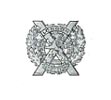 |
|
| Regimental Colour |
Cap Badge |
|
The "London Scottish Rifle Volunteers" were formed
in 1859. On the establishment of the Territorial Force the Scottish
were re-numbered as the 14th (County of London) Battalion, the
London Regiment. The colours were presented by King Edward VII
at Windsor in 1909, while a King's Colour was given to the 2nd
Battalion in 1919. During the Great War the regiment expanded
to three battalions. The 1st (pre-war) Battalion went out to
France in September 1914, and came under fire on October 1st.
The 2nd Battalion went to France in 1916 while the 3rd was a
Home Service Battalion. |
| 20th Battalion
London Regiment T.A. |
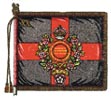 |
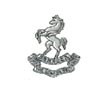 |
|
| Regimental Colour |
Cap Badge |
|
This battalion of the London Regiment wears the White Horse
of Kent as its Cap Badge - at one time it was a Volunteer Battalion
of the Royal West Kent Regiment. The Queen's Own wear black
facings (which were originally those of the Royal West Kents)
in their scarlet full dress, hence the unusual shade of the
Regimental Colour. The H.Q. are at Blackheath; the regiment
marches past to "A Hundred Pipers". In the Great War
the 20th mustered three battalions, serving in France and Flanders,
Macedonia and Palestine. |
|